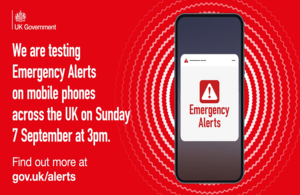Click here to buy secure, speedy, and reliable Web hosting, Cloud hosting, Agency hosting, VPS hosting, Website builder, Business email, Reach email marketing at 20% discount from our Gold Partner Hostinger You can also read 12 Top Reasons to Choose Hostinger’s Best Web Hosting
Millions of UK phone users worry: “Why did my phone suddenly blare a siren?” That shock—especially if you’re driving, caring for someone vulnerable, or managing a workplace—can cause real confusion and stress. With another national test scheduled, it’s important to know whether the alert is a test or real, who gets it, and what practical steps you should take (or avoid) when your device sounds. This article explains the upcoming test, how the UK Emergency Alert system works, what it can and cannot do, and provides clear, usable actions you can take today to be prepared.
3 VPNs That Pass All Tests (2025)
- NordVPN: Zero leaks in tests, RAM-only servers, and Threat Protection to block malware.
- Surfshark: Unlimited devices, Camouflage Mode for bypassing VPN blocks, and CleanWeb ad-blocker.
- ExpressVPN: Trusted Server tech (data wiped on reboot) and consistent streaming access.
What’s happening
The UK government will run a national test of the UK Emergency Alert system on Sunday 7 September at around 15:00. The test will send a loud siren-like tone to compatible 4G and 5G mobile phones and tablets across the UK, followed by a message that it’s only a test.
How the system works

The Emergency Alerts system uses Cell Broadcast technology. Unlike text messages, which target a phone number, cell broadcast sends a short message to every compatible device connected to a mobile mast in a geographic area. That’s why your phone can sound even if it’s on silent, not connected to Wi-Fi, or you don’t have the sender’s number saved.
Key operational points (short):
Works on most iPhones (iOS 14.5+) and Android devices (Android 11+) but older handsets may miss alerts.
Phones do not need to be signed up or linked to your identity; the system does not require your phone number.
In real emergencies, alerts carry instructions (e.g., “Evacuate now,” “Seek shelter”) so follow them.
What you’ll see and hear during the test
A 10-second siren-like tone (approx.) and vibration, even if the phone is in silent mode.
A screen message that clearly states the alert is a test and that no action is required.
A small percentage of devices will not receive the test (older phones, 2G/3G-only devices, phones turned off, or those with emergency alerts manually disabled).
What this test is really for — beyond the noise
Many people react only to the alarm. The government runs these tests to:
Verify nationwide reach and that wireless operators can broadcast to cell areas quickly.
Identify coverage gaps (older phones, rural areas, or certain network cells).
Improve accessibility — ensuring alerts reach people who use assistive tech, multiple languages, or who rely on secondary devices.
How businesses and local services should treat the alert
Most public coverage treats the test as a civilian exercise. Here’s a fresh angle: organisations should treat this as an operational readiness drill.
Practical steps for local businesses, schools, and community groups:
Run a simple internal drill at 15:05 (after the test) — confirm how staff receive the alert and how your incident response starts.
Check older/shared devices (cash registers, tablets, staff phones) for compatibility — if a shared device is 2G/3G only it will miss alerts.
Update emergency plans to include “phone alert received” as a trigger for particular actions (e.g., close doors, log incident, open internal comms).
Communicate with customers/patients: post a notice on doors or website saying “You may have heard a national test at 3pm — this is not an emergency.” This reduces anxiety and inbound calls.
Accessibility audit: ensure your comms reach deaf or visually impaired customers who might not hear the siren — use SMS or email follow-ups where needed.
This operational framing helps communities move from surprise to purposeful action when a real alert comes.
Where UK Emergency Alert System have already Helped
The system has been used for targeted local warnings — for example, to advise residents around an unexploded WWII bomb in Plymouth and during flash floods in other areas. Those alerts were local, targeted, and carried instructions that helped agencies manage evacuations and public safety. These real deployments show the system can work as part of a layered response (TV, radio, door-to-door) when time is critical.
Common concerns — answered
Q: Can the government track me through the alerts?
A: No. Cell Broadcast doesn’t send data back to the government about which phones received the message; it’s a one-way broadcast.
Q: Will I get spam or marketing messages?
A: No. The system is restricted to emergency services and authorised public bodies.
Q: My phone vibrated twice — is that normal?
A: Some Android devices may show reminder notifications for the same alert. You can change that behavior in your phone’s emergency alerts settings.
How to opt out or change settings (quick, safe steps)
If the siren is a real concern (for carers, people with sensory sensitivities, or devices used in quiet environments), you can limit which alerts you get—but be cautious: that may stop a real life-saving message.
To change alerts on iPhone: Settings → Notifications → scroll to Government Alerts → toggle Severe or Extreme alerts on/off.
On Android: Settings → search “emergency alerts” (or Safety & Emergency / Wireless Emergency Alerts) → toggle Severe, Extreme, and Test Alerts as needed.
If you opt out, consider a secondary plan: radio, TV, or a neighbor check-in for major incidents. (These steps are device-level; details vary by manufacturer and OS version.)
Tip: If you rely on a “backup phone” for safety (e.g., an old handset), make sure it’s compatible — otherwise you’ll miss alerts.
Limitations and what authorities still need to fix
Device fragmentation: millions of phones remain incompatible. That’s a coverage blind spot that will persist until handsets are refreshed.
False positives and multiple reminders: can cause alarm fatigue; clearer UX on reminders is needed.
Accessibility gaps: some users need BSL or Easy Read formats; advance outreach must be improved. The government provides BSL/Easy Read materials for tests, but local delivery could be better coordinated.
Key Takeaways
National test: A UK Emergency Alert system test will run at 3pm on 7 September; expect a loud siren and a test message.
How it works: The system uses cell broadcast to reach compatible 4G/5G phones without needing your phone number.
Not all phones will get it: Older devices, phones off or in airplane mode, and some tablets may miss alerts.
Businesses should use the test as a drill: confirm internal processes and shared device coverage.
You can adjust alerts on your device but consider backup plans if you opt out.
FAQs (People Also Ask)
Q: Will the emergency alert sound even if my phone is on silent?
A: Yes — the alert is designed to override silent and Do Not Disturb settings for life-safety notices.
Q: Can I turn test alerts off but keep real emergency alerts on?
A: Some devices offer separate toggles for test alerts; others group them with severe/extreme alerts. Check your settings and manufacturer guidance.
Q: What should I do if I get an alert while driving?
A: Don’t check your phone while driving. Pull over safely or rely on passenger/radio instructions — then follow the emergency alert advice.
Q: Where can I find past alerts and examples?
A: The government publishes past alerts and examples on GOV.UK’s Emergency Alerts pages.
Sources: UK government Emergency Alerts pages and guidance on how the alerts work and the national test. GOV.UK
Now loading...






